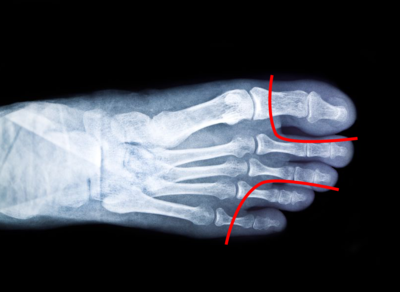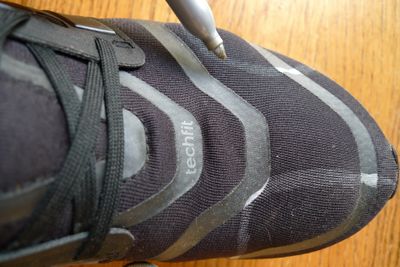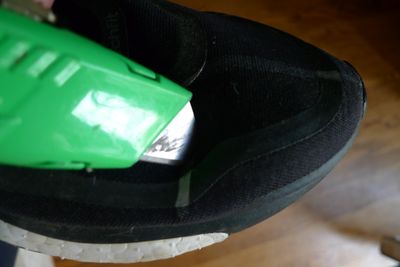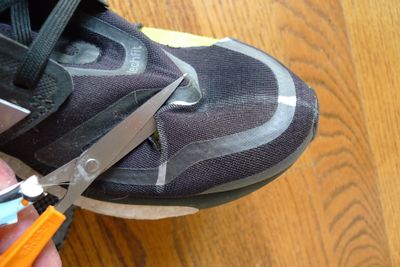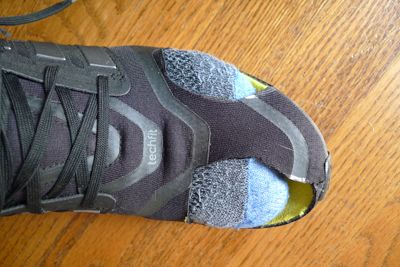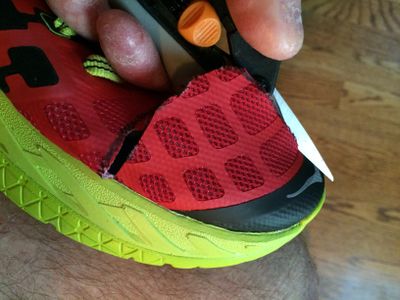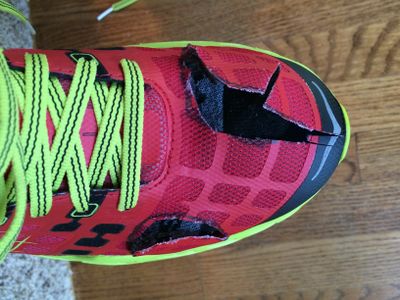Difference between revisions of "Shoe Modifications"
User:Fellrnr (User talk:Fellrnr | contribs) (Created page with "[[File:ModifiedShoes.JPG|right|thumb|300px|Clockwise from the top: [http://www.roadrunnersports.com/rrs/products/NIK1444/ Nike Free 3.0] (early version) cut open more than mos...") |
User:Fellrnr (User talk:Fellrnr | contribs) |
||
| Line 1: | Line 1: | ||
| − | [[File:ModifiedShoes.JPG|right|thumb| | + | [[File:ModifiedShoes.JPG|right|thumb|400px|Clockwise from the top: [http://www.roadrunnersports.com/rrs/products/NIK1444/ Nike Free 3.0] (early version) cut open more than most to form a 'running sandal', [http://www.roadrunnersports.com/rrs/products/SCN984/ Saucony Hattori], [http://www.roadrunnersports.com/rrs/products/NBA1542/ NB Trail Minimus], [http://www.roadrunnersports.com/rrs/products/NIK1444/ Nike Free 3.0] and the non-minimalist [[Hoka Shoe Review|Hoka]].]] |
| − | I cut open the toe box of nearly every shoe I run in to prevent blisters. I | + | I cut open the toe box of nearly every shoe I run in to prevent blisters and to improve comfort. I started doing this to [[Blister Prevention| prevent blisters on ultramarathons]], but over time I found that an open toe box allows my feet to move more naturally. When you run, your toes will tend to splay out at toe off, something that is inhibited by most running shoes. Of course, most people are reluctant to take a knife to their expensive running shoes, so I recommend trying get on an older pair of shoes that are close to the end of their life. This allows you to experiment with relatively little consequence. While cutting open the toe box can dramatically improve your comfort, there are limits to what it can do. If the toe box is too small, then your feet will hang over the edge of the midsole. A common concern with cutting open the toe box is getting depraved into your shoe. My experience is that this is only a problem when walking, or running through undergrowth. It's extremely rare for me to get something in my shoes while running. |
| − | |||
{| class="wikitable" | {| class="wikitable" | ||
|- valign="top" | |- valign="top" | ||
| − | |[[File: | + | |[[File:Shoe Modifications.png|none|thumb|400px| It's critical to know where to cut the toe box so I've used an x-ray image to give you a sense of where the cut lines are in relation to your joints. The most critical part of the cut is where it begins at the sides of the shoe. I've found the best cart starts just ahead of the metatarsal joint. This is just in front of the bulge that forms the ball of your foot on the inside edge. This ensures that the shoe is in contact with the main part of your foot, and only your toes are free. If you cut too far back, the shoe will be excessively loose, and likely to rub on the edge of the ball of your foot. If you cut too far forward then your toes will rub as they splay. The other end of the cuts, at the front of the shoe, is far less critical. I simply cut so that I remove the material that would touch my toes, while aiming to leave a bridge that is far enough away from my toes that it would cause a problem. Some runners don't bother leaving a narrow bridge to the front of the shoe, but I prefer to leave it in place as I find it a little more comfortable.]] |
| − | |||
|- valign="top" | |- valign="top" | ||
| − | |[[File:ShoeModCut2.JPG|none|thumb| | + | |[[File:ShoeModMark.JPG|none|thumb|400px|Mark the line you want to cut with a marker that will show up clearly. Err on the side of cutting too little as it's easy to remove a little more later. With practice you get to know where to cut on the first go, but beginners may need to cut conservatively then go for a short run to see how it feels. Typically just a few minutes will tell you all you need to know. You can then repeatedly cut a little more and try again until you happy.]] |
| − | |[[File:ShoeModFinished.JPG|none|thumb| | + | |- valign="top" |
| + | |[[File:ShoeModCut1.JPG|none|thumb|400px|Make the initial cuts with a sharp knife. Be cautious at this stage, as you may have to press quite hard to penetrate the tough fabric, and it's easy to then count rather more than you expected.]] | ||
| + | |- valign="top" | ||
| + | |[[File:ShoeModCut2.JPG|none|thumb|400px|I use short, sharp sewing scissors for , as they have far more control than a knife. However, you may find some bits of reinforcement that need you to go back to the knife.]] | ||
| + | |- valign="top" | ||
| + | |[[File:ShoeModFinished.JPG|none|thumb|400px|Here's the finished result.]] | ||
| + | |- valign="top" | ||
| + | |[[File:AltShoeMod2.jpg|none|thumb|400px| A modification to the process is to leave the flap of material in place. With this approach you cut around the red line in the x-ray photo above, but you don't count along the upper away from the midsole.]] | ||
| + | |- valign="top" | ||
| + | |[[File:AltShoeMod1.jpg|none|thumb|400px| Here you can see the results of this partial "shoe-ectomy". This approach doesn't give quite the same level of freedom as completely removing the flap, but it does have some other advantages. You're less likely to get debris in your shoe when walking, as the flap partly covers the opening (it doesn't help much when slogging your way through long grass or undergrowth.) The flap also tends to keep your toes a tiny bit warmer, which is good in winter, but bad in summer. The main benefit is that you're less likely to get rubbing from the edge of the midsole, which can occasionally be an issue.]] | ||
|} | |} | ||
=Downsides= | =Downsides= | ||
There are some downsides to cutting open the toe box. | There are some downsides to cutting open the toe box. | ||
| − | * You can't return shoes you've cut open. | + | * You can't return shoes you've cut open. In fact, you can't really even give them away! |
* It's rather disconcerting to cut open shoes you've just paid a lot of money for. | * It's rather disconcerting to cut open shoes you've just paid a lot of money for. | ||
* The shoes can rip open because of the extra stress of the cuts. However, in the thousands of miles I've been running in shoes cut open, I've only had two pairs tear and then only after a lot of miles. | * The shoes can rip open because of the extra stress of the cuts. However, in the thousands of miles I've been running in shoes cut open, I've only had two pairs tear and then only after a lot of miles. | ||
* You can get debris into the shoe. I've only found this to be an issue when walking, not running unless I'm running through long grass. | * You can get debris into the shoe. I've only found this to be an issue when walking, not running unless I'm running through long grass. | ||
Revision as of 11:22, 14 May 2016

I cut open the toe box of nearly every shoe I run in to prevent blisters and to improve comfort. I started doing this to prevent blisters on ultramarathons, but over time I found that an open toe box allows my feet to move more naturally. When you run, your toes will tend to splay out at toe off, something that is inhibited by most running shoes. Of course, most people are reluctant to take a knife to their expensive running shoes, so I recommend trying get on an older pair of shoes that are close to the end of their life. This allows you to experiment with relatively little consequence. While cutting open the toe box can dramatically improve your comfort, there are limits to what it can do. If the toe box is too small, then your feet will hang over the edge of the midsole. A common concern with cutting open the toe box is getting depraved into your shoe. My experience is that this is only a problem when walking, or running through undergrowth. It's extremely rare for me to get something in my shoes while running.
Downsides
There are some downsides to cutting open the toe box.
- You can't return shoes you've cut open. In fact, you can't really even give them away!
- It's rather disconcerting to cut open shoes you've just paid a lot of money for.
- The shoes can rip open because of the extra stress of the cuts. However, in the thousands of miles I've been running in shoes cut open, I've only had two pairs tear and then only after a lot of miles.
- You can get debris into the shoe. I've only found this to be an issue when walking, not running unless I'm running through long grass.
